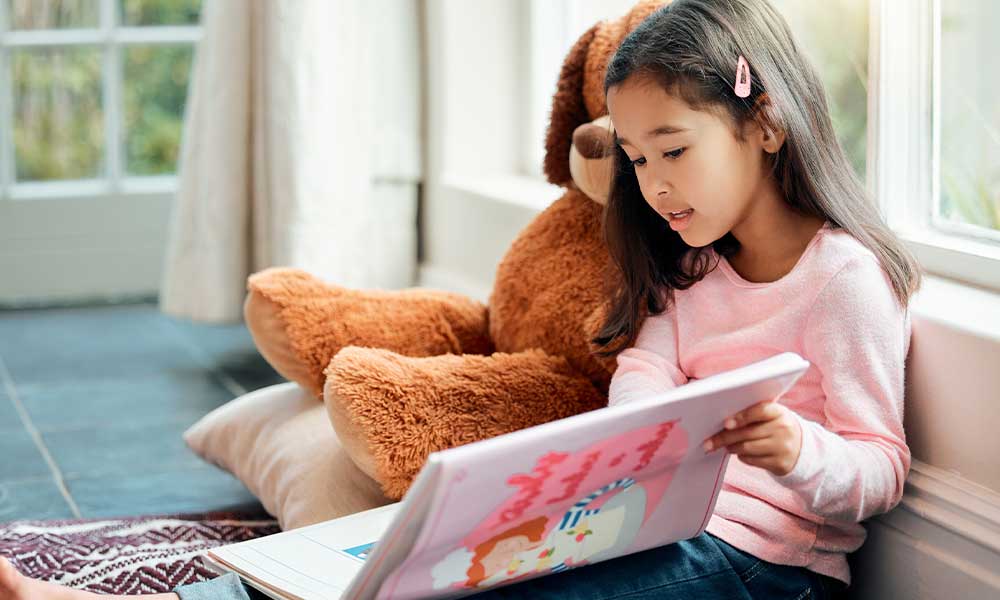Listen close, I want to tell you a story...
People around the world have told stories for centuries. Stories have the power to gather, teach, entertain, and soothe. Human brains are wired for stories. A good story boosts oxytocin levels and can cause brain changes that last for days. Stories make information more memorable. Here’s why storytelling can benefit everyone in your household:
Stories make your kids smarter
Researchers say storytelling is a natural and essential part of linguistic development from early childhood onwards. A study suggests that when children hear a vocabulary word spoken, they learn to read it more easily later. I don’t often use the words “glisten” or “gleam” in conversation, but I used them both in "Magical Pony" bedtime stories this week. Honing storytelling skills gives kids a leg up in school for tasks like crafting written narratives and demonstrating reading comprehension.
Stories help you rock your professional and personal lives
Contributors to the “Harvard Business Review” hail storytelling as the best tool leaders can use to establish a sense of connection and craft powerful presentations. They even go so far as to call it an irresistible strategic business tool. Whoa.
Your ability to spin an engaging yarn can make or break your success in social situations. Nothing kills an evening like getting trapped listening to an endless saga, or worse, in the awkward silence of "I Have Nothing To Talk About With This Person."
Telling stories together fosters family closeness. Storytelling is portable and requires no gadgets, batteries, or anything else to weigh down your diaper bag.
With all these pluses, how do you turn your family into storytellers?
Make it a daily routine
Adults and children can "tell the story of their day” during your commute or family meal. When I frame my request this way, I hear more than “nothing” about what my kids did at school. With mine, I show them how even spotting a goldfinch or finding my lost sunglasses can be narrative-worthy.
Take a cue from preschool teachers
One of my first jobs was a preschool aide. One night a local restaurant burned down and many of the children drove past the wreckage on the way to school. The seasoned teacher started that day by acting out what happened with dolls: they discovered the fire in the block “restaurant,” called the fire department, who bravely put it out and made sure no one was hurt, and made plans to rebuild. Telling the story of a difficult event can be comforting.
Stories can also prepare children for upcoming events. When I took frequent red-eye flights with my toddler to visit family, “We Will Go to Sleep on the Airplane” got a lot of mileage.
Don’t reinvent the wheel
There’s a reason fairy and folk tales have been enjoyed for centuries. In a moment of desperation I once settled my rowdy kids with an impromptu retelling of “The Boy Who Cried Wolf.” This became a favorite for months. (Full disclosure: it did not inspire my toddler to stop fibbing.)
Kids can retell, too. Show younger children how to act out familiar stories with toys and add their own twists. How about a house built of wooden play food for the second little pig? Older kids can come up with new story versions or compete for the most dramatic retelling, honing their creativity and performance skills.
Build a story brick by brick
Jason Boog, author of “Born Reading: Bringing Up Bookworms in a Digital Age – From Picture Books to eBooks and Everything in Between,” tells parents to approach storytelling like building a Lego structure: one brick at a time. Start with the simple foundation of a few characters and a setting. Layer on events that build up to a problem or climax and top it off with a satisfying conclusion. Take cues from children’s play: magical elements and the classic good versus evil power struggle are attractive.
Concoct your personal story recipe. When I’m especially exhausted, mine is something like this: Kids take a walk in the forest. Kids find something that imparts special powers. Kids go on a magical adventure. Kids go home. Kids go to sleep so Mom can too.
Create your family’s characters
When my oldest son was potty training, he was afraid to use the real toilet. I took stuck a fly decal in the toilet bowl. Soon the fly had a name and even acquired a friend. Zippy and Twirly starred in family stories for years. Recurring characters appeal to kids and give you a go-to story foundation.
Pass on family stories
Hold the magical blueberries and talking insects, some of the best stories are ones from your own family history. Research shows that hearing family stories builds empathy, contributes to positive identity formation, and can even reduce the risks of anxiety and depression.
Play it up
Like many things in parenting, turning storytelling into a game is always a reliable move. Open a magazine in the doctor’s waiting room and tell each other stories inspired by the photos. Resurrect the classic tag-team game of telling alternating sentences.
A family campfire always works to get everyone’s narrative juices flowing, whether it’s an actual backyard s’more-making affair or a rainy afternoon on the couch with a crackling fire playing on your flat screen. (Need more ideas? Check out "Show Me a Story: 40 Craft Projects and Activities to Spark Children's Storytelling" by Emily Neuburger.)
Storytelling brings out the best of what it is to be human – creativity, intellect, emotion, and connection. Find a listener and go tell your story.



